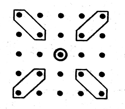为什么要将非线性滤波和线性滤波结合起来使用?
因为单独使用非线性滤波的计算量较大(需要对其模板下的所有像素的灰度值排序),结合计算量较小的线性滤波,可达到(接近)期望要求。
结合的步骤(以均值滤波和中值滤波结合为例)
- 对较大区域进行线性滤波
- 计算线性滤波输出的中值作为混合滤波的结果
以1-D信号混合为例
是一个 1-D 信号,用子结构
、
、
、......、
组成的线性中值混合滤波可定义为:
![]()
对一副图像进行线性中值混合滤波
模板:

对圈起来的像素分别求其灰度值的均值,再取四个均值和中心像素灰度值(共五个元素)的中值为滤波结果图像的模板中心像素的灰度值。
代码实现:
import cv2
import numpy as np
import matplotlib.pyplot as plt
from time import time
from math import ceil
def nonlin(image):
"""
非线性中值滤波函数
:param image:输入图像
:return:滤波结果图像
"""
# 扩充边界
border_filling = cv2.copyMakeBorder(image, 2, 2, 2, 2, cv2.BORDER_REPLICATE)
image_lin_and_nolin = image.copy()
# 漫游重合
for i in range(2, border_filling.shape[0] - 2):
for j in range(2, border_filling.shape[1] - 2):
# 读取需要的像素点的灰度值
all_of_list = []
for s in range(i-2, i+3):
for t in range(j-2, j+3):
all_of_list.append(border_filling[s][t])
# 对灰度值列表排序并取中值
all_of_list.sort()
image_lin_and_nolin[i - 2][j - 2] = all_of_list[12]
return image_lin_and_nolin
def lin_and_nolin(image):
"""
线性平均滤波和非线性中值滤波相结合的函数
:param image: 输入图像
:return: 滤波结果
"""
# 扩充边界
border_filling = cv2.copyMakeBorder(image, 2, 2, 2, 2, cv2.BORDER_REPLICATE)
image_lin_and_nolin = image.copy()
# 漫游重合
for i in range(2, border_filling.shape[0]-2):
for j in range(2, border_filling.shape[1]-2):
# 读取需要的像素点的灰度值
part_of_list = [int((int(border_filling[i-1][j-1]) + int(border_filling[i-2][j-2])) / 2),
int((int(border_filling[i+1][j+1]) + int(border_filling[i+2][j+2])) / 2),
int((int(border_filling[i+1][j-1]) + int(border_filling[i+2][j-2])) / 2),
int((int(border_filling[i-1][j+1]) + int(border_filling[i-2][j-2])) / 2)]
# 对所有组成区域的像素点求平均值
#linear_result = [int(np.mean(part_of_list[0:5])), int(np.mean(part_of_list[5:10])),
# int(np.mean(part_of_list[10:15])), int(np.mean(part_of_list[15:])),
# border_filling[i][j]]
"""
刚开始用的是np.mean函数来对各个区域像素求均值,但是发现结果和理论不符,
改进之后不使用该函数发现结果快了很多
"""
# 对平均值结果排序并取中值
part_of_list.sort()
image_lin_and_nolin[i-2][j-2] = part_of_list[2]
return image_lin_and_nolin
# 加椒盐噪声的函数
def saltPepper(image, salt, pepper):
height = image.shape[0]
width = image.shape[1]
pertotal = salt + pepper #总噪声占比
noiseImage = image.copy()
noiseNum = int(pertotal * height * width)
for i in range(noiseNum):
rows = np.random.randint(0, height-1)
cols = np.random.randint(0,width-1)
if(np.random.randint(0,100)<salt*100):
noiseImage[rows,cols] = 255
else:
noiseImage[rows,cols] = 0
return noiseImage
def show_images(images):
'''
显示函数
:param images:
:return:
'''
for i in range(len(images)):
img = images[i]
#行,列,索引
x = 1
plt.subplot(x, ceil(len(images)/x), i+1)
plt.imshow(img, cmap="gray")
title = "("+str(i+1)+")"
plt.title(title,fontsize=10)
plt.xticks([])
plt.yticks([])
plt.show()
if __name__ == "__main__":
image = cv2.imread("images\\flower8.jpg", 0)
imageNoise = saltPepper(image, 0.075, 0.075)
begin1 = time()
for i in range(10):
image_nolin = nonlin(imageNoise)
end1 = time()
begin2 = time()
for i in range(10):
image_lin_nolin = lin_and_nolin(imageNoise)
end2 = time()
time1 = end1 - begin1
time2 = end2 - begin2
print("使用5*5模板时:")
print("仅使用非线性中值滤波处理一张图像10次的时间为:", time1)
print("使用线性均值和非线性中值混合滤波处理一张图像10次的时间为:", time2)
images = [image, imageNoise, image_nolin, image_lin_nolin]
show_images(images)
控制台结果:

图像输出:

(1)原始图像
(2)加了椒盐噪声的图像
(3)仅使用非线性中值滤波5×5模板处理的结果图像
(4)使用线性中值混合滤波5×5模板滤波处理的结果图像
放大图:

结论:
就去噪效果而言,单独使用非线性滤波确实比线性非线性混合滤波好一些,但是就其速度而言,相对于单独使用非线性滤波是快了很多的,应用中可根据实际需求来择优使用。








 本文探讨了非线性滤波与线性滤波结合使用的原理,通过对比实验展示了结合使用这两种滤波方法在去噪效果与处理速度上的优势。文章详细介绍了结合滤波的步骤,并提供了具体的代码实现。
本文探讨了非线性滤波与线性滤波结合使用的原理,通过对比实验展示了结合使用这两种滤波方法在去噪效果与处理速度上的优势。文章详细介绍了结合滤波的步骤,并提供了具体的代码实现。
















 1万+
1万+

 被折叠的 条评论
为什么被折叠?
被折叠的 条评论
为什么被折叠?








